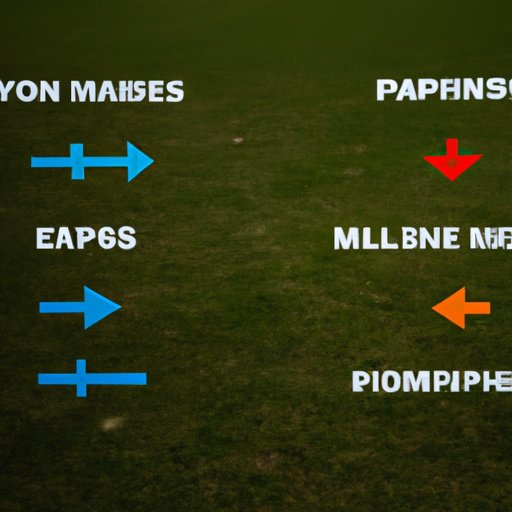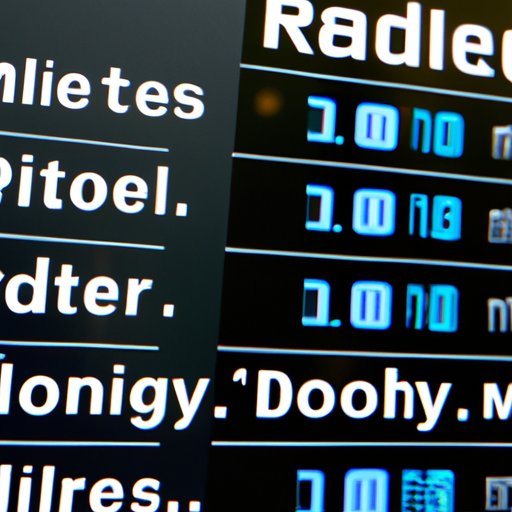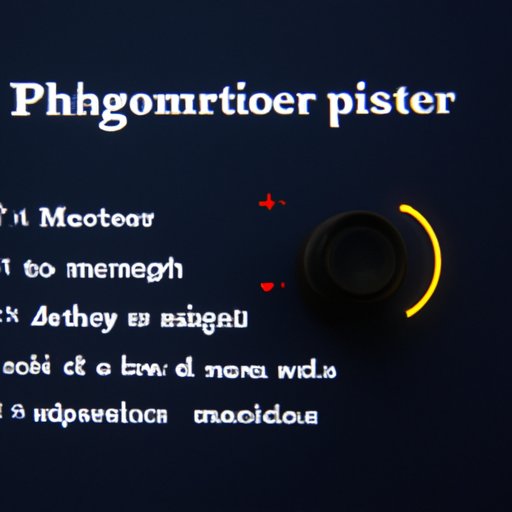Introduction
Metering mode is a feature found in most digital cameras that allows photographers to measure the amount of light in a scene and adjust the exposure accordingly. It’s an important tool for any photographer, but it’s especially important for sports photography. In this article, we’ll explore what metering mode is, why it’s important to choose the right metering mode for sports photography, and how to choose the right metering mode for your needs.

How to Choose the Right Metering Mode for Sports Photography
When choosing the right metering mode for sports photography, the first step is to evaluate the scene. Consider the lighting conditions, the subject’s movements, and the composition of the image. Once you’ve evaluated the scene, you can begin to explore the different metering modes available.
Evaluative/Matrix Metering
Evaluative or matrix metering is the most common type of metering mode and is generally the default setting on most cameras. Evaluative metering takes into account the entire scene, breaking it down into multiple segments and measuring each segment individually. This allows the camera to create a balanced exposure that captures the entire scene as accurately as possible.
Partial Metering
Partial metering is similar to evaluative metering, but it only measures a portion of the scene. This is usually the center of the frame, but some cameras allow you to select a specific area to focus on. Partial metering is useful for capturing detail in a specific area of the frame, such as a sports player’s face.
Spot Metering
Spot metering is the most precise form of metering available. It measures a very small area of the scene, usually just a few pixels in size. This makes it ideal for capturing detail in high contrast scenes, as it allows you to precisely measure the light in a specific area. Spot metering is often used to capture the details of a sports player’s face in a brightly lit stadium.
Center-Weighted Average Metering
Center-weighted average metering is a combination of evaluative and spot metering. It takes into account the entire scene, but places emphasis on the center of the frame. This makes it ideal for capturing detail in the center of the frame while still capturing the rest of the scene accurately. Center-weighted average metering is often used in sports photography when the focus is on a specific athlete or team.
A Beginner’s Guide to Understanding Metering Modes for Sports Photography
For those new to photography, understanding metering modes can be daunting. To make it easier to understand, let’s break down the basics of metering modes for sports photography.
Breaking Down the Basics of Metering Modes
The main types of metering modes are evaluative/matrix, partial, spot, and center-weighted average. Each type of metering mode measures light differently, so it’s important to understand how each type works before making a decision. Here’s a quick overview of each type:
- Evaluative/Matrix Metering: Measures the entire scene and breaks it down into multiple segments.
- Partial Metering: Measures a portion of the scene, usually the center.
- Spot Metering: Measures a very small area of the scene, usually just a few pixels in size.
- Center-Weighted Average Metering: Combines evaluative and spot metering, measuring the entire scene with emphasis on the center.
Tips for Choosing the Right Metering Mode
Now that you understand the basics of metering modes, here are some tips for choosing the right one for your sports photography:
- Evaluate the scene – consider the lighting conditions, the subject’s movements, and the composition of the image.
- Choose the metering mode that best suits the scene – if the scene is evenly lit, evaluative/matrix metering may be the best choice; if there is a lot of contrast, spot metering may be the better option.
- Experiment – take some test shots using different metering modes to see which one gives the best results.

Exploring the Benefits of Different Metering Modes for Sports Photography
Each metering mode has its own unique benefits for sports photography. Let’s explore each one in more detail.
Evaluative/Matrix Metering
Evaluative/matrix metering is the most versatile metering mode, as it can handle a wide range of lighting conditions. It’s also the easiest to use, as the camera does all the work for you. The main benefit of this metering mode is that it produces a balanced exposure that captures the entire scene accurately.
Partial Metering
Partial metering is best used for capturing detail in a specific area of the frame. This is useful for sports photography, as it allows you to focus on a particular player or team without sacrificing the overall composition of the image. It’s also great for capturing detail in high contrast scenes, as it allows you to precisely measure the light in a specific area.
Spot Metering
Spot metering is the most precise form of metering available and is ideal for capturing detail in high contrast scenes. It’s also useful for capturing detail in a specific area of the frame, such as a sports player’s face. The main benefit of spot metering is that it allows you to precisely measure the light in a specific area.
Center-Weighted Average Metering
Center-weighted average metering is a great choice for sports photography, as it combines evaluative and spot metering. It takes into account the entire scene, but places emphasis on the center of the frame. This makes it ideal for capturing detail in the center of the frame while still capturing the rest of the scene accurately.

What Professional Photographers Need to Know About Metering Modes for Sports Photography
For professional photographers, understanding metering modes for sports photography is essential. Here are some tips for getting the most out of your metering modes:
Pre-Shot Preparations
Before taking a shot, it’s important to evaluate the scene and choose the right metering mode for the situation. Take some test shots using different metering modes to see which one gives the best results.
Utilizing Light and Shadow
Light and shadow can be used to great effect in sports photography. Utilize different metering modes to capture the nuances of light and shadow in a scene. For example, spot metering can be used to capture detail in a specific area of the frame, while center-weighted average metering can be used to balance the light and dark areas of the scene.
Knowing When to Switch Modes
In some cases, switching between metering modes may be necessary. For example, if you’re shooting in a brightly lit stadium, you may need to switch to spot metering to capture the details of a sports player’s face. Conversely, if you’re shooting in a low light situation, you may need to switch to evaluative/matrix metering to ensure a balanced exposure.
A Comprehensive Look at the Different Metering Modes for Sports Photography
By now, you should have a good understanding of the different metering modes available for sports photography. Here’s a quick overview of each type:
Evaluative/Matrix Metering
Evaluative/matrix metering is the most versatile metering mode, as it can handle a wide range of lighting conditions. It’s also the easiest to use, as the camera does all the work for you. The main benefit of this metering mode is that it produces a balanced exposure that captures the entire scene accurately.
Partial Metering
Partial metering is best used for capturing detail in a specific area of the frame. This is useful for sports photography, as it allows you to focus on a particular player or team without sacrificing the overall composition of the image. It’s also great for capturing detail in high contrast scenes, as it allows you to precisely measure the light in a specific area.
Spot Metering
Spot metering is the most precise form of metering available and is ideal for capturing detail in high contrast scenes. It’s also useful for capturing detail in a specific area of the frame, such as a sports player’s face. The main benefit of spot metering is that it allows you to precisely measure the light in a specific area.
Center-Weighted Average Metering
Center-weighted average metering is a great choice for sports photography, as it combines evaluative and spot metering. It takes into account the entire scene, but places emphasis on the center of the frame. This makes it ideal for capturing detail in the center of the frame while still capturing the rest of the scene accurately.
Conclusion
Metering mode is an important tool for any photographer, but it’s especially important for sports photography. In this article, we explored what metering mode is, why it’s important to choose the right metering mode for sports photography, and how to choose the right metering mode for your needs. We also looked at the benefits of different metering modes for sports photography, as well as what professional photographers need to know about metering modes for sports photography. By understanding the different metering modes and how they can be used in sports photography, you’ll be able to get the most out of your camera and take stunning photos.
Summary
Metering mode is an important tool for any photographer, but it’s especially important for sports photography. In this article, we explored what metering mode is, why it’s important to choose the right metering mode for sports photography, and how to choose the right metering mode for your needs. We also looked at the benefits of different metering modes for sports photography, as well as what professional photographers need to know about metering modes for sports photography.
Further Resources
If you want to learn more about metering mode for sports photography, here are some great resources to check out:
- Metering Modes Explained
- Metering Mode Guide for Sports Photography
-
(Note: Is this article not meeting your expectations? Do you have knowledge or insights to share? Unlock new opportunities and expand your reach by joining our authors team. Click Registration to join us and share your expertise with our readers.)
